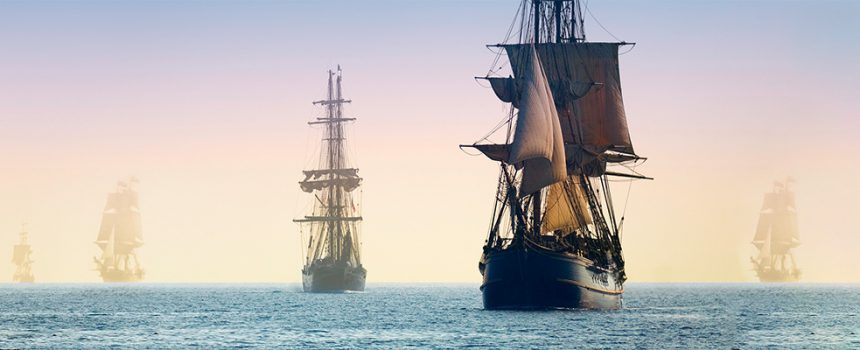The subject of trade is of vital importance today. It was the forefront of our new President’s campaign and has been at the top of his list of tasks as he assumed office. It is the subject of my recent ebook Trade: A Time for War…or Peace? Because of its global nature, I don’t think there are too many subjects as important for our planet at this time…for where there is truly prospering trade, there can be no war. Nations engaged in trade are not engaged in battle.
Trade plays a key role in sales, and it is of great benefit for anyone engaged in any level of sales to learn the fundamentals of the trade. It is also of great benefit to understand how trade has evolved–for every evolution in trade has had a profound impact on sales.
Like any endeavor, trade has evolved through time and has passed through stages. Because each stage contributes to the current state of trade, a way to refer to each of these stages is as dimensions. Each dimension contributes and becomes a foundation for the next.
First Dimension: The Roads
The first dimension of trade goes all the way back to the beginning of our history on this planet. At the dawn of man, we had roving nomadic tribes. Shortly after that, we had some of these tribes remaining stationary and engaging in agriculture–the growing of crops of the raising of animals. Not long after that, we had people crafting goods that would be traded for necessities.
People who remained stationary then formed small nations. Some of these nations grew to enormous sizes, such as China, but most others remained small.
As trade began to evolve, two major trade routes rose to prominence and lasted for thousands of years.
The first of these was what is today referred to as the Amber Road, the history of which goes all the way back to the 16th century BC. The Amber Road was a route that connected the North Sea and the Baltic Sea, over land, to the Mediterranean, and was defined by the trade of amber. Amber was sometimes dubbed “The Gold of the North” and was greatly important in prehistoric trade. For example, large amber beads can be found in the breast ornament of the Egyptian pharaoh Tutankhamun (ca. 1333-1324 BC). An enormous quantity of amber was found in the Royal Tomb of Qatna, Syria. History records that amber was sent as an offering from the North Sea to the Roman temple of Apollo at Delphi.
The second of these roads was what is today referred to as the Silk Road. The Silk Road has a fascinating history, from the first main artery the Persian Royal Road established around 500 B.C. Alexander the Great, and then the Greeks, each played roles in expanding the routes. While many different kinds of merchandise traveled along these routes, the network gets its name from the popularity of Chinese silk in the west, particularly in Rome. At its height, the Silk Road routes stretched from China through India, Asia Minor, up throughout Mesopotamia, to Egypt, the African continent, Greece, Rome, and Britain.
Of considerable if not chief importance during this period was Venice, for it was from Venice that Marco Polo and other important merchants ventured forth and actually established these trade routes between Asia and Europe.
Of interesting note is the fact that no one was prevented from traveling in those days–no one was stopped at a border and asked to present their passport. It bears an interesting resemblance to today’s Internet which, although many powers seek to prevent it, also operates in many ways without borders.
Second Dimension: The Ships
The second dimension of trade actually has its beginnings in about 450 BC, when the ancient historian Herodotus created the first map of the world as it was known at that time. Such maps had a profound impact on this second dimension, that of sailing ships.
Sailing ships originated in ancient times with the Egyptians, Phoenicians, Romans, and others. Assailing became more advanced, sailing ships became the methods by which empires were operated: the Dutch, the English, the Spanish, the Portuguese, the Italian. Sailing ships reached prominence in the 15th century–and the dimension that they added to trade was that they enhanced and then bypassed the land routes that had become heavily controlled. Sailing ships began carrying spices from Asia around Africa’s Cape of Good Hope, and into Europe, totally leaving behind previous land routes. Ships made it possible to develop trade links across both the Pacific and the Atlantic oceans and opened up trade with the native peoples of the Americas.
For our purposes here, we could consider that this second dimension also included the more modern ships propelled by engines. They were certainly faster and larger, but they still utilized the same means.
Impact on Sales
It can be seen that none of these dimensions would have occurred without salespeople. The ancient roads were traveled by merchants. They would not have come about and thrived had it not been for the salespeople of the day, who would be gone from home for years at a stretch.
The same can be said for the ships–in fact, the “salespeople” that operated these ships took enormous risks, stocking their vessels with goods to be traded across oceans. They had no idea if those goods would be accepted or not, or even if they would make it there and back.
While it’s certainly not the same level of risk and length of time traveling, we can see how these dimensions proudly reflect in the entrepreneurial salespeople (who I refer to as salespreneurs) of today.
Pipeliner CRM has been developed to empower the salespreneurs of today. Find out more.






















Comments